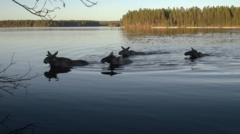The unique annual event allows viewers to connect with wildlife while highlighting the fascinating movement patterns of Sweden's moose.
"Millions Tune In as Swedish Moose Embark on Their Annual Migration"

"Millions Tune In as Swedish Moose Embark on Their Annual Migration"
A communal appreciation for nature unfolds as millions watch the livestream of the Great Moose Migration.
Every year, as spring rolls in, a captivating event unfolds in northern Sweden, attracting millions to a continuous livestream of moose making their way across the Angerman River. "The Great Moose Migration," broadcasted by SVT Play, kicked off its annual coverage early this year in response to warmer weather, showing that nature is unpredictable yet mesmerizing.
This environmental experience—having become a hallmark of the "slow TV" movement since its inception in 2019—has garnered an enthusiastic following, including audiences who tune in for a full 24 hours a day. Cait Borjesson, a dedicated viewer since discovering the stream during the COVID-19 pandemic, describes the soothing ambiance of the broadcast: “It feels like therapy,” she shared, noting how the natural sounds create a sense of being immersed in nature.
With a vibrant community blossoming around the stream, a Facebook group with over 77,000 members thrives as fans exchange stories, emotional moments, and a passion for wildlife conservation. This cozy, yet impactful social gathering echoes the terrestrial experiences shared by viewers who look on as the moose migrate back to summer pastures after congregating in warmer spots during winter. According to Goran Ericsson, a dean at the Swedish University of Agricultural Sciences, about 95% of the moose in the northern regions migrate annually, an echo from the dynamics established even since the ice age.
As part of the slightly earlier migration this year, viewers from around the globe had the opportunity to witness moose traverse through the village of Kullberg while capturing the majestic landscapes with more than 30 strategically placed cameras. The show’s popularity skyrocketed, drawing nearly one million viewers during its launch in 2019 and reaching staggering heights of nine million in 2024.
Minh-Xuan Truong, a researcher in the field, emphasizes how in our fast-paced, media-driven society, many find solace in the simplicity of nature depicted through "slow TV." He points out that audiences overwhelmingly prefer the genuine sounds of the forest over any kind of commentary or music, providing a window into nature that comforts, fascinates, and educates. As the seasonal migration rolls on, nature enthusiasts and environmental advocates alike cherish the majestic moose, colloquially known in Sweden as the "King of the Forest."
This environmental experience—having become a hallmark of the "slow TV" movement since its inception in 2019—has garnered an enthusiastic following, including audiences who tune in for a full 24 hours a day. Cait Borjesson, a dedicated viewer since discovering the stream during the COVID-19 pandemic, describes the soothing ambiance of the broadcast: “It feels like therapy,” she shared, noting how the natural sounds create a sense of being immersed in nature.
With a vibrant community blossoming around the stream, a Facebook group with over 77,000 members thrives as fans exchange stories, emotional moments, and a passion for wildlife conservation. This cozy, yet impactful social gathering echoes the terrestrial experiences shared by viewers who look on as the moose migrate back to summer pastures after congregating in warmer spots during winter. According to Goran Ericsson, a dean at the Swedish University of Agricultural Sciences, about 95% of the moose in the northern regions migrate annually, an echo from the dynamics established even since the ice age.
As part of the slightly earlier migration this year, viewers from around the globe had the opportunity to witness moose traverse through the village of Kullberg while capturing the majestic landscapes with more than 30 strategically placed cameras. The show’s popularity skyrocketed, drawing nearly one million viewers during its launch in 2019 and reaching staggering heights of nine million in 2024.
Minh-Xuan Truong, a researcher in the field, emphasizes how in our fast-paced, media-driven society, many find solace in the simplicity of nature depicted through "slow TV." He points out that audiences overwhelmingly prefer the genuine sounds of the forest over any kind of commentary or music, providing a window into nature that comforts, fascinates, and educates. As the seasonal migration rolls on, nature enthusiasts and environmental advocates alike cherish the majestic moose, colloquially known in Sweden as the "King of the Forest."



















